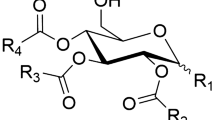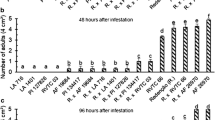Abstract
The Lycopersicon hirsutum var. hirsutum accession PI 127826 is recognized as a good source of resistance to arthropod pests due to the action of the allelochemical zimgiberene, a sesquiterpene present in its glandular trichomes. Five genotypes were selected from the F2 generation of the interspecific cross Lycopersicon esculentum ‘TOM-556’ × Lycopersicon hirsutum var. hirsutum ‘PI 127826’, based on their low levels (BPX-368-clone#56) or high levels(BPX-368-clone#92, BPX-368-clone#105,BPX-368-clone#179, BPX-368-clone#250) of zingiberene. The five F2 genotypes were tested for resistance to the South American tomato pinworm Tuta absolutaalong with accession L. esculentum ‘TOM-556’ (pinworm susceptible), and the accessions L. hirsutum var. hirsutum ‘PI 127826’ and L. pennellii ‘LA716’ (resistant). The F2 clones selected for high foliar zingiberene levels showed lower scores for leaflet lesion type(LLT), percent leaflets attacked (PLA) and overall plant damage (OPD) than the low zingiberene genotypes. The results indicated that zingiberene mediates resistance to the South American pinworm, based on feeding and on ovipositing deterrence, in populations derived from the interspecific cross between Lycopersicon. esculentum and Lycopersicon hirsutum var. hirsutum. Indirect selection for high foliar zingiberene content is suggested as an efficient technique for breeding tomatoes for resistance to the South American tomato pinworm.
Similar content being viewed by others
References
Aragão, C.A., 1998. Tricomas foliares associados à resistência ao ácaro rajado em linhagens de tomateiro com alto teor de 2-tridecanona nos folíolos. Universidade Federal de Lavras, Lavras-MG, Brazil. 71 p (M.S. Thesis) (in Portuguese).
Barbara, E.L., D.W. Lawson, K.K. White, J.A. Shapiro, D.E. Cohen, W.G. Carson, J.T. Trumble & M.A. Mutschler, 1995. Acylsugars of wild tomato Lycopersicon pennellii alters settling and reduces oviposition of Bemisia argentifilii (Homoptera: Aleyrodidae). J Econ Entomol 88: 742-748.
Carter, C.D. & J.C. Snyder, 1986. Mite responses and trichome characters in a full-sib F2 family of Lycopersicon esculentum × L. hirsutum. J Amer Soc Hortic Science 111: 130-133.
Carter, C.D., J.N. Sacalis & T.J. Gianfagna, 1988. Resistance to Colorado Potato Beetle in relation to zingiberene content of Lycopersicon species. Rep Tomato Genet Coop 38: 11-12.
Carter, C.D., J.N. Sacalis & T.J. Gianfagna, 1989. Zingiberene and resistance to Colorado potato beetle in Lycopersicon hirsutum f. hirsutum. J Agric & Food Chem 37: 206-210.
Carvalho, R., C. Basso, I. Scatoni & F. Comotto, 1981. Ensayo para el control de Scrobipalpula absoluta (Meyrick) temporada 1980-1981. Revista Técnica, Montevideo 50: 41-46 (in Spanish).
Castelo-Branco, M., F.H. França, C.M.T. Cordeiro, W.R. Maluf & A.M. Resende, 1987. Seleção em F2(Lycopersicon esculentum × L. pennellii) visando resistência à traça do tomateiro. Horticultura Brasileira 5: 30-32 (in Portuguese).
Coelho, M.C.F. & F.H. França, 1987. Biologia e quemotaxia da larva e descrição da pupa e adulto da traça-do-tomateiro. Pesquisa Agropecuária Brasileira 22: 129-135 (in Portuguese).
Eigenbrode, S.D. & J.T. Trumble, 1993. Antibiosis to beet armyworm (Spodoptera exigua) in Lycopersicon accessions. HortScience 28: 932-934.
Eigenbrode, S.D., J.T. Trumble, J.G. Millar & K.K. White. 1994. Topical toxicity of tomato sesquiterpenes to the beet armyworm and the role of these compounds in resistance derived from an accession of Lycopersicon hirsutum f. typicum. J Agric & Food Chem 42: 807-810.
França, F.H., W.R. Maluf, P.E.F. Rossi, J.E.C. Miranda & M.C.F. Coelho, 1984. Avaliação e seleção em tomate visando resistência à traça-do-tomateiro. In: Congresso Brasileiro de Olericultura, 24. Resumos, Sociedade de Olericultura do Brasil, p. 143 (Abstr.) (in Portuguese).
Freitas, J.A., 1999. Resistência genética de tomateiro Lycopersicon spp. à mosca branca Bemisia spp. mediada por zingibereno contido em tricomas glandulares. Universidade Federal de Lavras, Lavras-MG, Brazil, 93 p., (Doctoral Thesis) (in Portuguese).
Freitas, J.A., W.R. Maluf, M.G. Cardoso, L.A.A. Gomes & E. Bearzotti, 2002. Inheritance of foliar zingiberene contents and their relationship to trichome densities and whitefly resistance in tomatoes. Euphytica 127: 275-287.
Goffreda, J.C., M.A. Mutschler, D.A. Avé, W.M. Tingey & J.C. Steffens, 1989. Aphid deterrence by glucose esters in glandular trichome exudate of wild tomato Lycopersicon pennellii. J Chem Ecol 15: 2135-2147.
Gonçalves, M.I.F., W.R. Maluf, L.A.A. Gomes & L.V. Barbosa, 1998. Variation of 2-Tridecanone level in tomato plant leaflets and resistance to two mite species (Tetranychus sp.). Euphytica 104: 33-38.
Gonçalves-Gervásio, R.C.R., 1998. Aspectos biológicos e parasitismo de ovos de Tuta absoluta (Meyrick, 1917) (Lepidoptera: Gelechiidae) por Trichogramma pretiosum Riley, 1879 (Hymenoptera: Trichogrammatidae) em genótipos de tomateiro contrastantes quanto ao teor de 2-tridecanona nos folíolos. Universidade Federal de Lavras, Lavras-MG, Brazil, 71 p., (M.S. Thesis) (in Portuguese).
Haji, F.N.P., J.R.P. Parra, J.P. Silva & J.G.S. Batista, 1988. Biologia da traça do tomateiro sob condições de laboratório. Pesquisa Agropecuária Brasileira 23: 107-110 (in Portuguese).
Labory, C.R.G., L.V.C. Santa-Cecília, W.R. Maluf, M.G. Cardoso, E. Bearzotti & J.C. Souza, 1999. Seleção indireta para teor de 2-tridecanona em tomateiros segregantes e sua relação com a resistência à traça do tomateiro. Pesquisa agropecuária brasileira, 34: 733-740 (in Portuguese). Lourenção, A.L. & H. Nagai, 1983. Fontes de resistência a Scrobipalpula absoluta (Meyrick, 1917) em tomateiro. In: Congresso brasileiro de Olericultura, 23. Rio de Janeiro: SOB, p. 53 (in Portuguese).
Lourenção, A.L., H. Nagai & M.A.T. Zulo, 1984. Fontes de resistência a Scrobipalpula absoluta (Meyrick, 1917) em tomateiro. Bragantia 43: 569-577 (in Portuguese).
Maluf, W.R., L.V. Barbosa & L.V.C. Santa-Cecília, 1997. 2-Tridecanone-mediated mechanisms to resistance to the South American tomato pinworm Scrobipalpuloides absoluta (Meyrick, 1917) (Lepidoptera-Gelechiidae) in Lycopersicon spp. Euphytica 93: 189-194.
Maluf, W.R., G.A. Campos & M.G. Cardoso, 2001. Relationships between trichome types and spider mite (Tetranychus evansi) repellence in tomatoes with respect to foliar zingiberene contents. Euphytica 121: 73-80.
Povoly, D., 1975. On three Neotropical species of Gnorimoschemini (Lepidoptera-Gelechiidae) mining Solanaceae. Acta Universitatis Agriculturae Facultas Agronomica, Brno 2: 379-393.
Resende, J.T.V., W.R. Maluf, F.V. Resende, M.V. Faria, L.D. Gonçalves, P.F. Vargas, F.O. Naves, V.C. Andrade-Junior, A.M. Santos-Junior, A.B. Azevedo, L.A.A. Gomes, V. Licursi & P. Moretto, 2002a. AcilaçÚcares presentes nos folíolos conferem resistência à traça Tuta absoluta em tomateiro. Horticultura Brasileira 20: Suplemento 2 (CD Rom).
Resende, J.T.V., W.R. Maluf, M.G. Cardoso, D.L. Nelson & M.V. Faria, 2002b.Inheritance of acylsugar contents in tomatoes derived from an interspecific cross with the wild tomato Lycopersicon pennellii and their effect on spider mite repellence. Genet & Mol Res 1: 106-116.
Snyder, J.C., D.A. Johnson, D.E. Good & P.A. Weston, 1987. Type VI trichome exudates from genotypes of L. hirsutum f. glabratum. Rep Tomato Genet Coop 37: 67-68.
Souza, J.C. & P.R. Reis, 1992. Traça-do-tomateiro: histórico, reconhecimento, biologia, prejuízos e controle. Belo Horizonte: EPAMIG. Boletim Técnico EPAMIG, 2, 15 p. (in Portuguese).
Vargas, H.C., 1970. Observaciones sobre la biologia y enemigos naturales de la polilla del tomate, Gnorimoschema absoluta (Meyrick) (Lep., Gelechiidae). Idesia 1: 75-110 (in Spanish).
Weston, P.A., A.D. Johnson, H.T. Burton & J.C. Snyder, 1989. Trichome secretion composition, trichome densities, and spider mite resistance of ten accessions of Lycopersicon hirsutum. J Amer Soc Hort Sci 114: 492-498.
Williams, W.G., G.G. Kennedy, E.T. Yamamoto, J.D. Thacker & J. Bordner, 1980. 2-Tridecanone, a naturally occurring insecticide from the wild tomato Lycopersicon hirsutum f. glabratum. Science 207: 888-889.
Author information
Authors and Affiliations
Corresponding author
Rights and permissions
About this article
Cite this article
de Azevedo, S.M., Ventura Faria, M., Maluf, W.R. et al. Zingiberene-mediated resistance to the South American tomato pinworm derived from Lycopersicon hirsutum var. hirsutum . Euphytica 134, 347–351 (2003). https://doi.org/10.1023/B:EUPH.0000005007.14924.d2
Issue Date:
DOI: https://doi.org/10.1023/B:EUPH.0000005007.14924.d2




